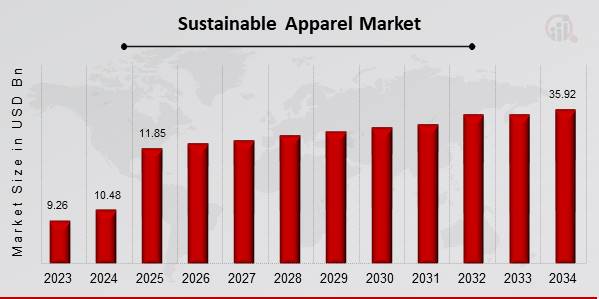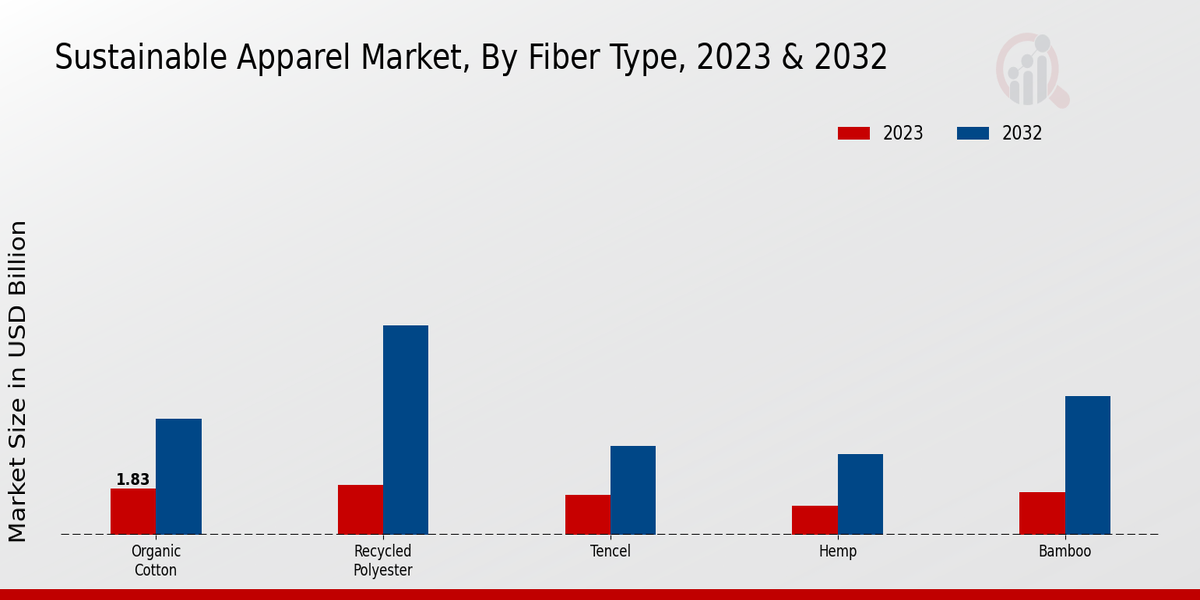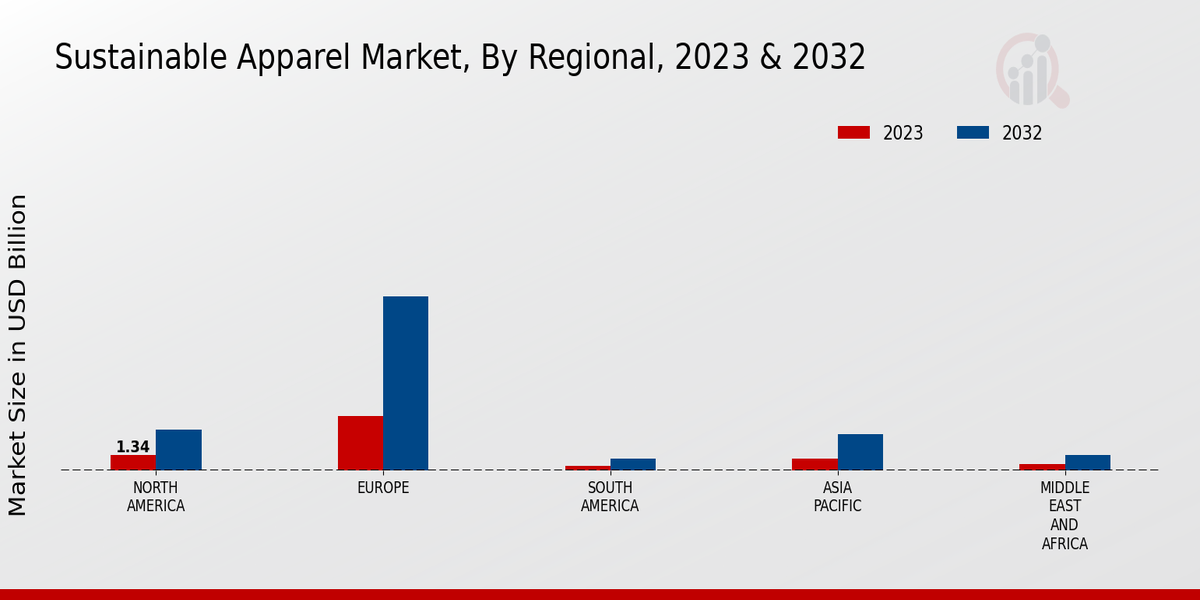Global Sustainable Apparel Market Overview
Sustainable Apparel Market Size was estimated at 10.48(USD Billion) in 2024. The Sustainable Apparel Market is expected to grow from 11.85(USD Billion) in 2025 to 35.92 (USD Billion) by 2034. The Sustainable Apparel Market CAGR (growth rate) is expected to be around 13.1% during the forecast period (2025 - 2034).

Source Primary Research, Secondary Research, MRFR Database and Analyst Review
Key Sustainable Apparel Market Trends Highlighted
The key market drivers for sustainable apparel include a growing consumer demand for addressing environmental and social issues, as well as an increasing preference for responsible and sustainable offerings. The need for textiles that are produced in an environmentally safe process is driving the market expansion.
Prevalent opportunities in the sustainable apparel market are focused on the creation of new, advanced materials, particularly bio-based and biodegradable linens, as well as the improvement of production processes. There are opportunities for developing circular fashion by integrating fashion brands and green initiatives.
Recent initiatives within the sustainable apparel industry involve integrating technology to improve supply chain transparency as well as tracking materials’ sources and sustainability using blockchain technology. There is a shift from the ownership economy to the rental and subscription model amongst brands in a bid to boost circularity whilst consumers are adopting fair-trade certified and upcycled fashion.
Sustainable Apparel Market Drivers
Rising Awareness of Environmental Issues
Consumers are becoming increasingly aware of the environmental impact of their clothing choices. They are looking for sustainable options that are produced in an environmentally friendly way and that have a low carbon footprint. This trend is expected to continue in the coming years, as more and more consumers become aware of the importance of sustainability. The growing awareness of environmental issues is one of the key drivers of the growth of the Sustainable Apparel Market Industry.
Consumers are becoming increasingly concerned about the environmental impact of their clothing choices, and they are looking for sustainable options that are produced in an environmentally friendly way and that have a low carbon footprint. This trend is expected to continue in the coming years, as more and more consumers become aware of the importance of sustainability. In addition to the growing awareness of environmental issues, there are a number of other factors that are driving the growth of the Sustainable Apparel Market Industry.
These factors include The increasing popularity of online shopping, which makes it easier for consumers to find sustainable clothing options. The growing availability of sustainable clothing options from a variety of brands and retailers. The increasing affordability of sustainable clothing options. The Sustainable Apparel Market Industry is expected to grow significantly in the coming years, as more and more consumers become aware of the importance of sustainability.
This growth will be driven by a number of factors, including the increasing popularity of online shopping, the growing availability of sustainable clothing options, and the increasing affordability of sustainable clothing options.
Government Regulations
Many governments around the world are implementing regulations to reduce the environmental impact of the apparel industry. These regulations are likely to affect the growth of the Sustainable Apparel Market Industry. One of the most important regulations is the European Union’s Ecodesign Directive. This directive requires that all new clothing products sold in the EU must be designed to be durable, repairable, and recyclable. This directive is likely to have a significant impact on the growth of the Sustainable Apparel Market Industry.
It will be difficult for companies to sell clothing products that are not sustainable. There are also a number of other regulations that are being implemented throughout the world to reduce the environmental impact of the apparel industry. These regulations include the following The California Sustainable Apparel and Home Furnishings Act. The New York Fashion Sustainability Act. The UK Sustainable Clothing Action Plan. Each of these regulations is likely to have a positive impact on the growth of the Sustainable Apparel Market Industry.
It will be difficult for companies to sell clothing products that are not sustainable.
Technological Advancements
Technological advancements are making it easier for companies to produce sustainable clothing products. These advancements are expected to have a positive impact on the growth of the Sustainable Apparel Market Industry. Technological advancements are making it easier for companies to produce sustainable clothing products. These advancements are expected to have a positive impact on the growth of the Sustainable Apparel Market Industry. One of the most important technological advancements is the development of new materials.
These materials are more sustainable than traditional materials, and they can be used to produce clothing products that are more durable, repairable, and recyclable. In addition to the development of new materials, there are a number of other technological advancements that are making it easier for companies to produce sustainable clothing products. These advancements include The development of new production processes. The development of new recycling technologies.
The development of new software tools. These technological advancements are expected to have a positive impact on the growth of the Sustainable Apparel Market Industry, as they will make it easier for companies to produce sustainable clothing products that meet the needs of consumers.
Sustainable Apparel Market Segment Insights
Sustainable Apparel Market Fiber Type Insights
Driven by consumer preference for eco-friendly and sustainable products, the increasing adoption of ethical sourcing practices in the fashion industry, and growing awareness of the environmental impact of traditional textile production, the sustainable apparel market has seen significant growth in recent years. The fiber type segment of the market offers diverse options that cater to the evolving consumer demand for sustainable materials. Organic Cotton Organic cotton cultivation emphasizes sustainable farming techniques, such as crop rotation, natural pest control, and avoidance of synthetic fertilizers and pesticides, reducing the environmental impact compared to conventional cotton farming.
The Organic Textile Standard (GOTS) certifies organic cotton production, ensuring the highest environmental and social standards throughout the supply chain. As of 2023, the organic cotton segment held a significant share of the sustainable apparel market, valued at approximately USD 1.98 billion and is projected to maintain steady growth in the coming years. Recycled Polyester Recycled polyester is derived from post-consumer plastic bottles or other polyester waste, offering an eco-friendly alternative to virgin polyester. The recycling process reduces the environmental footprint by conserving resources and diverting waste from landfills.
The recycled polyester segment is projected to witness substantial growth in the coming years, with an estimated valuation of USD 2.12 billion by 2032. Tencel (Lyocell) Tencel, a lyocell fiber, is made from sustainably sourced wood pulp using a closed-loop production process that minimizes water consumption and chemical usage. Tencel offers exceptional breathability, moisture management, and a soft, silky feel. The Tencel segment is anticipated to grow steadily, with an estimated valuation of USD 1.69 billion by 2032. Hemp Hemp, a versatile natural fiber, is gaining traction in the sustainable apparel industry due to its durability, breathability, and antimicrobial properties.
Hemp cultivation requires minimal water and chemicals, making it an eco-friendly choice. The hemp segment is expected to experience significant growth, with an estimated valuation of USD 1.24 billion by 2032. Bamboo Bamboo, a rapidly renewable resource, is emerging as a sustainable fiber option in the apparel industry. Bamboo fabric is biodegradable, moisture-wicking, and has natural antibacterial properties. The bamboo segment is projected to witness substantial growth in the coming years, with an estimated valuation of USD 1.83 billion by 2032.
Overall, the fiber type segment of the Sustainable Apparel Market is characterized by strong growth potential, driven by consumer demand for eco-friendly and sustainable products. The diverse range of fiber options available, each with unique properties and environmental benefits, caters to the evolving needs of consumers and the fashion industry's commitment to sustainability.

Source Primary Research, Secondary Research, MRFR Database and Analyst Review
Sustainable Apparel Market Certification Insights
Certification plays a crucial role in the sustainable apparel industry, ensuring ethical and environmentally conscious practices. Among the prominent certifications are the Organic Textile Standard (GOTS), which verifies the organic status of textiles throughout the supply chain, from harvesting to processing and manufacturing. Fair-trade Fair-trade certification ensures fair wages, safe working conditions, and sustainable farming practices for farmers and workers involved in the production of sustainable apparel. OEKO-TEX 100 OEKO-TEX 100 certifies textiles as free from harmful substances, making them safe for human health and the environment.
B Corp Certification B Corp Certification recognizes businesses that meet high standards of social and environmental performance, transparency, and accountability. Sustainable Apparel Coalition (SAC) SAC is a alliance that promotes sustainable practices in the apparel industry and provides tools and resources for certification. These certifications have gained significant traction in the market, indicating a growing demand for transparency and sustainability in the apparel sector. Consumers are increasingly seeking products that align with their values and are produced responsibly, driving the growth of certified sustainable apparel.
Sustainable Apparel Market Production Process Insights
Within the Sustainable Apparel Market, the Production Process segment presents immense opportunities for growth. This growth is largely attributed to rising consumer awareness about environmental sustainability and ethical practices in the fashion industry. Waterless Dyeing, a key process in sustainable apparel, eliminates the use of water in the dyeing process, significantly reducing water consumption and wastewater generation. The market for Waterless Dyeing is projected to reach USD 2.7 billion by 2024. Low-Impact Manufacturing focuses on reducing energy consumption, waste generation, and greenhouse gas emissions throughout the production process.
This segment is estimated to grow at a CAGR of 12.8% over the forecast period. Zero Waste Design aims to eliminate waste by optimizing fabric usage and utilizing innovative patterns and cutting techniques. The Ethical Sourcing segment ensures responsible sourcing of raw materials, promoting fair labor practices and environmental protection. Upcycling, the process of transforming waste or discarded materials into new products, is gaining traction as a sustainable alternative to traditional manufacturing. The Sustainable Apparel Market industry players are increasingly investing in these innovative Production Processes to meet consumer demand for eco-friendly and ethical fashion options.
The market segmentation provides valuable insights into the evolving dynamics and growth potential of sustainable apparel production, enabling stakeholders to make informed decisions and capitalize on market opportunities.
Sustainable Apparel Market Product Type Insights
The Sustainable Apparel Market is segmented by Product Type into Apparel, Footwear, Accessories, Home Textiles, and Activewear. In 2023, the Apparel segment held the largest market share, accounting for over 50% of the revenue. The Footwear segment is expected to grow at the highest CAGR during the forecast period, driven by increasing demand for sustainable and ethical footwear options. The Accessories segment is also expected to witness significant growth, owing to the rising popularity of sustainable fashion accessories such as bags, jewelry, and hats.
The Home Textiles segment is expected to grow steadily, driven by the increasing demand for sustainable home décor and bedding products. The Activewear segment is expected to grow at a moderate pace, driven by the growing popularity of sustainable and ethical activewear options.
Sustainable Apparel Market Regional Insights
The Sustainable Apparel Market is segmented into North America, Europe, APAC, South America, and MEA. In 2023, North America accounted for the largest market share, with a revenue of 3.45 billion USD. Europe is expected to be the fastest-growing region, with a CAGR of 13.8% during the forecast period. APAC is expected to be the second-largest market, with a revenue of 2.6 billion USD in 2023. South America and MEA are expected to grow at a CAGR of 12.5% and 11.9%, respectively, during the forecast period. The growth of the sustainable apparel market is being driven by increasing consumer awareness about the environmental and social impacts of the fashion industry.
Consumers are increasingly demanding products that are produced in an ethical and sustainable manner. This has led to a growing demand for sustainable apparel, which is expected to continue in the coming years. Key factors driving the growth of the sustainable apparel market include Increasing consumer awareness about the environmental and social impacts of the fashion industry. Growing demand for products that are produced in an ethical and sustainable manner. Government regulations and initiatives promoting sustainability in the fashion industry.
Technological advancements in sustainable apparel production. Growing availability of sustainable apparel products.

Source Primary Research, Secondary Research, MRFR Database and Analyst Review
Sustainable Apparel Market Key Players And Competitive Insights
Major players in the Sustainable Apparel Market industry are actively engaged in product innovation and strategic collaborations to gain a competitive edge. Leading Sustainable Apparel Market players are focusing on developing sustainable and eco-friendly products to cater to the growing consumer demand for environmentally conscious fashion. The development of the sustainable apparel market is driven by the increasing adoption of sustainable practices and the rising awareness of environmental concerns among consumers.
Patagonia, a leading company in the Sustainable Apparel Market, has been at the forefront of sustainability for decades. The company uses recycled materials, organic cotton, and fair trade practices to create high-quality, durable garments. Patagonia's commitment to sustainability has earned it a loyal customer base and recognition as a leader in the industry. The company has also expanded its product offerings to include outdoor gear and accessories, further strengthening its position in the Sustainable Apparel Market.
A competitor company, H&M, has also made significant strides in sustainability. The company has set ambitious goals to reduce its environmental footprint, including using more recycled materials and reducing water consumption. H&M has also launched a number of initiatives to promote sustainable fashion, such as its Conscious Collection and its partnership with the Ellen MacArthur Foundation. These efforts have helped H&M to become a major player in the Sustainable Apparel Market and appeal to environmentally conscious consumers.
Key Companies in the Sustainable Apparel Market Include
-
Patagonia
-
Puma
-
Inditex
-
Stella McCartney
-
Esprit
-
Gap
-
Levi Strauss Co.
-
Kering
-
Eileen Fisher
-
The North Face
-
Nike
-
Adidas
-
Reformation
Sustainable Apparel Market Industry Developments
The sustainable apparel market is projected to reach USD 24.8 billion by 2032, exhibiting a CAGR of 13.11% from 2023 to 2032. Key factors driving market growth include rising consumer awareness about the environmental and social impacts of fast fashion, increasing demand for eco-friendly and ethical products, and government initiatives promoting sustainability in the textile industry. Recent developments include the launch of sustainable collections by major fashion brands, collaborations between fashion designers and environmental organizations, and investments in innovative technologies for sustainable textile production. The market is expected to witness significant growth in the coming years due to increasing consumer demand for sustainable and ethical fashion options.
Sustainable Apparel Market Segmentation Insights
Sustainable Apparel Market Fiber Type Outlook
Organic Cotton
Recycled Polyester
Tencel
Hemp
Bamboo
Sustainable Apparel Market Certification Outlook
Organic Textile Standard (GOTS)
Fair-trade
OEKO-TEX 100
B Corp Certification
Sustainable Apparel Coalition (SAC)
Sustainable Apparel Market Production Process Outlook
Waterless Dyeing
Low-Impact Manufacturing
Zero Waste Design
Ethical Sourcing
Upcycling
Sustainable Apparel Market Product Type Outlook
Apparel
Footwear
Accessories
Home Textiles
Activewear
Sustainable Apparel Market Regional Outlook
North America
Europe
South America
Asia Pacific
Middle East and Africa
| Report Attribute/Metric |
Details |
| Market Size 2024 |
10.48 (USD Billion) |
| Market Size 2025 |
11.85 (USD Billion) |
| Market Size 2034 |
35.92 (USD Billion) |
| Compound Annual Growth Rate (CAGR) |
13.1% (2025 - 2034) |
| Report Coverage |
Revenue Forecast, Competitive Landscape, Growth Factors, and Trends |
| Base Year |
2023 |
| Market Forecast Period |
2025 - 2034 |
| Historical Data |
2019 - 2023 |
| Market Forecast Units |
USD Billion |
| Key Companies Profiled |
C, Patagonia, Puma, Inditex, Stella McCartney, Esprit, Gap, Levi Strauss Co., Kering, Eileen Fisher, The North Face, Nike, H, Adidas, Reformation |
| Segments Covered |
Fiber Type, Certification, Production Process, Product Type, Regional |
| Key Market Opportunities |
Increased consumer preference Government regulations Growing awareness Technological advancements Emerging markets |
| Key Market Dynamics |
Rising consumer awareness, Government initiatives, Technological advancements, Increasing investments in RampD, Growing adoption of circular fashion |
| Countries Covered |
North America, Europe, APAC, South America, MEA |
Frequently Asked Questions (FAQ) :
The Sustainable Apparel Market was valued at USD 35.92 billion in 2024.
The Sustainable Apparel Market is expected to reach USD 35.92
billion by 2034.
The Sustainable Apparel Market is projected to grow at a CAGR of 13.1% from 2025 to 2034.
Asia-Pacific is expected to be the fastest-growing region in the Sustainable Apparel Market, with a CAGR of 14.22% during the forecast period.
Sustainable apparel has applications in various industries, including fashion, sportswear, and athleisure.
Key competitors in the Sustainable Apparel Market include Patagonia, Eileen Fisher, Reformation, and Stella McCartney.
Key trends driving the growth of the Sustainable Apparel Market include rising consumer awareness about sustainability and environmental concerns.
Challenges faced by the Sustainable Apparel Market include the high cost of sustainable materials and the lack of consumer awareness about sustainable fashion.
Opportunities for growth in the Sustainable Apparel Market include the development of new sustainable materials and technologies, and the increasing demand for sustainable fashion.
The COVID-19 pandemic is expected to have a short-term negative impact on the Sustainable Apparel Market, due to disruptions in supply chains and a decrease in consumer spending. However, the long-term outlook for the market remains positive, as consumers are increasingly seeking sustainable and ethical fashion options.
















